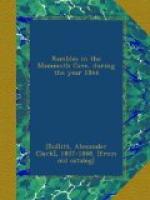Not very far from this point, we ascended a hill on our left, and walking a short distance over our shoe-tops in dry nitrous earth, in a direction somewhat at a right angle with the avenue below, we arrived at the Pine Apple Bush, a large column, composed of a white, soft, crumbling material, with bifurcations extending from the floor to the ceiling. At a short distance, either to the right or left, you have a fine view of the avenue some twenty feet below, both up and down. Why this crumbling stalactite is called the Pine Apple Bush, I cannot divine. It stands however in a charming, secluded spot, inviting to repose; and we luxuriated in inhaling the all-inspiring air, while reclining on the clean, soft and dry salt petre earth.
All lovers of romantic scenery ought to visit this avenue, and all dyspeptic hypochondriacs and love-sick despondents should do likewise, for there is something wonderfully exhilarating in the air of Pensico. Our friend B. remarked while rolling on the salt petre earth at the Pine Apple Bush, that he felt “especially happy,” and whether from sympathy, air or what not, we all partook of the same feeling. The guide seeing the position of our fat friend, and hearing his remark, said, laughing most immoderately, “these sort of feelings would come over one, now and then in the Cave, but wait till you get in the Winding Way and see how you feel then.”
Having descended into the avenue we had left, we passed a number of stalactites and stalagmites, bearing a remarkable resemblance to coral, and a hundred or more paces beyond, arrived at a recess on the left, lined with innumerable crystals of dog-tooth spar, shining most brilliantly, called Angelica’s Grotto. One would think it almost sacrilege to deface a spot like this; yet, did a Clergyman (the back of the guide being turned,) deliberately demolish a number of beautiful crystals to inscribe the initials of his name.
Returning to the head of Pensico Avenue, we turned to our right, and entered the narrow pass which leads to the river, pursuing which, for a few hundred yards, descending all the while, at one or two places down a ladder or stone steps, we came to a path cut through a high and broad embankment of sand, which very soon conducted us to the much talked of and anxiously looked for Winding Way. The Winding Way, has, in the opinion of many, been channeled in the rock by the gradual attrition of water. If this be so, and appearances seem to support such belief, at what early age of the world did the work commence? Was it not when “the earth was without form and void,” thousands of years perhaps, before the date of the Mosaic account of the Creation? The Winding Way is one hundred and five feet long, eighteen inches wide, and from three to seven feet deep, widening out above, sufficiently to admit the free use of one’s arms. It is throughout tortuous, a perfect zig-zag, the terror of the Falstaffs and the ladies of “fat,




